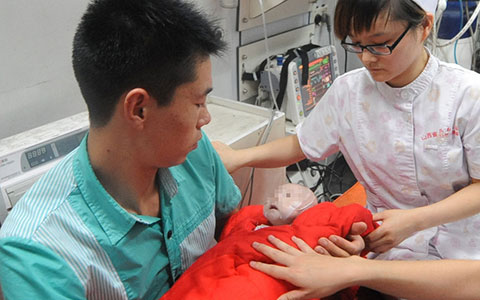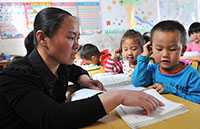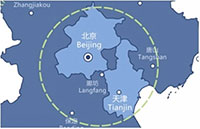National Human Rights Action Plan of China (2012-2015)
(Xinhua) Updated: 2012-06-11 16:20-- Improving the work-related injury insurance system covering prevention, compensation and rehabilitation. Work-related injury insurance will be put first under unified planning at the municipal level, and gradually unified planning at the provincial level. Proactive and steady efforts will be made in the prevention and rehabilitation of work-related injuries. By 2015, the subscribers to work-related injury insurance will reach 210 million.
-- Improving the maternity insurance system and by 2015 women subscribing maternity insurance will reach 150 million.
-- Increasing subsistence allowances and level of social relief for rural and urban residents. Work will be done to improve the subsistence allowance determining mechanism and dynamic adjustment mechanism and ensure that the average annual growth rate of the subsistence allowances reach 10%. And the subsistence allowances provided to rural residents enjoying the "Five Guarantees" (food, clothing, medical care, housing and burial expenses) will equal the average living standard of fellow villagers. Recipients of basic living allowances in both urban and rural areas will be classified, and more assistance will be granted to the aged, disabled, minors and seriously ill. By 2015, the urban and rural residents entitled to the subsistence allowances will make up around 6% of the total population, covering everyone in need. Steps will be taken to gradually lower or cancel the minimum payment line for medical treatment, and popularize the one-stop settlement model. The Measures for Assisting and Managing Urban Vagrants and Beggars with No Means of Livelihood will be revised, and a temporary aid system will be established all over the country.
(4) Right to health
China will establish initially a basic medical and health system that covers the entire nation, and improve the medical insurance system, public health service system and medical care system to protect the citizens' right to health.
-- Formulating a law on mental health, and making studies for the enactment of a law on basic medical and health care.
-- Continuously increasing the average life expectancy so that it will reach 74.5 years by 2015.
-- Strengthening the construction of primary-level medical and health care institutions and training bases for general practitioners. By 2015, China intends to train 150,000 general practitioners through job-transfer training, on-the-job training and standardized training.
-- Promoting equality in the right to basic health services. Efforts will be made to ensure that the per-capita spending for public health services is no less than 25 yuan around the country, and see to it that it will be raised to over 40 yuan by 2015. The state will also provide such free services as establishing health records, and providing health education and vaccination. The state will encourage blood donation without compensation and secure blood safety, and make sure that emergency medical services are permanently available.
-- Bringing infectious diseases under effective control. China will intensify efforts in prevention and control of major infectious diseases such as AIDS and cholera, and effectively control new infections and mortality caused by AIDS, viral hepatitis and tuberculosis. The rate of direct reporting on incidences of infectious diseases by medical and health institutions at/above the county level will be 100%. Endeavors will also be made to strengthen the prevention and treatment of infectious diseases among passengers on public transportation vehicles such as trains. The mechanism of joint prevention and control of major epidemics at land and sea ports will be established and medical media monitoring and pathogen detection will be strengthened at the ports.
-- Greater efforts will be made to prevent and treat chronic diseases. China will popularize knowledge in the prevention and treatment of chronic diseases, striving to achieve an awareness rate of 50% among core members in this regard. China will improve early detection, intervention and management of major chronic diseases and high-risk people, making sure that the awareness rate of blood pressure and blood sugar level by people of 35 years old and above reach 75% and 50%, respectively, and the management rate of hypertension and diabetes be no less than 40%. China will institute early detection and treatment of major cancers in 30% of areas with high incidences of cancer across the country.
-- Ensuring the safety of drinking water. China will promote the construction of a monitoring network for the safety of drinking water, and make its coverage extend to all cities divided into districts and over 90% of counties by 2015. The rural population with access to centralized water supply will be raised to 80%. Efforts will be made to make safe drinking water accessible to an additional 60 million rural people every year.
-- The Food Safety Law will be implemented, food safety monitoring system and food safety regulations and standards will be improved, and the responsibility will be determined for safe production of food. Stricter supervision will be enforced over all links of food processing and production, and the basic supervisory systems, such as the production licensing system, supervision and inspection system, recall system and label management system for food, food additives and food-related production, will be improved, so will the emergency plan for food safety accidents, the accident investigation and handling system and rapid response and handling system. China will bridge mechanisms between administrative law enforcement and criminal justice to severely punish criminal acts harming food safety.
-- Comprehensively implementing measures for prevention and control of endemic diseases, and basically eliminating such hazards. China will strive to eliminate iodine deficiency diseases in over 90% of the counties (cities and districts) in Hainan, Tibet, Qinghai and Xinjiang, and make sure that iodine deficiency diseases are eliminated in 95% of the counties (cities and districts) in other provinces (autonomous regions and municipalities directly under the central government). In areas with a high incidence of endemic fluorosis caused by coal burning, comprehensive preventive measures focusing on modifying and improving stoves will be adopted over 95% of the households. China will basically complete projects to provide safe drinking water and improve water quality in areas afflicted by endemic fluorosis and arseniasis which have been proved to be caused mainly by unsafe drinking water. Efforts will be made to bring under effective control fluorosis caused by tea drinking. Over 90% of the villages that are afflicted by Kaschin-Beck disease will have the disease eliminated, and over 90% of the counties where Keshan disease remains an endemic will have it eliminated.
-- Making studies for enactment of a law on traditional Chinese medicine and management methods of the standards of the medicinal materials. China will raise the national standards for drugs, improve the drug inspection and control system, strengthen drug safety monitoring and early warning, improve the drug safety emergency-response mechanism, fix in advance responsibility for the safe production and use of drugs, and ensure the quality and safety of basic drugs.
-- Forming a national fitness public service network covering all urban and rural residents and carrying out the National Fitness Program (2011-2015). Sports venues of various kinds will add up to over 1.2 million, with per-capita sports area being above 1.5 sq m. To achieve this goal, venues with sports facilities will be built in all cities, counties (districts), neighborhoods (townships) and communities (administrative villages). National fitness centers will be built in over 50% of the country's cities and counties (districts); convenient and practical fitness equipment will be installed in over 50% of neighborhoods (townships) and communities (administrative villages). Fitness stations will be established in over 50% of rural communities.
(5) Right to education
By implementing the Outline of the State Medium- and Long-term Program on Education Reform and Development (2010-2020), China will promote the balanced development of compulsory education throughout the country, develop pre-school education and vocational education, make senior high school education universal, improve the quality of higher education, achieve fairness in education, and raise the overall educational level of all Chinese citizens.
-- Consolidating the achievements in nine-year compulsory education. The net enrollment rate in elementary schools will remain at above 99%, gross enrollment rate in junior high schools will reach 99%, and the number of students graduating from compulsory education will reach 93% of the total enrollment. In addition, China will guarantee equal right to education for children of migrant workers, mainly relying on full-time public schools in cities they migrate to.
-- Allocating educational resources in balanced manner. China will promote standardized construction of schools of nine-year compulsory education and step up efforts in the renovation of school buildings in poor conditions; encourage exchanges of teachers between different schools within an area to narrow the gap among schools; allocate more educational resources to central and western regions, rural areas, remote and border areas, ethnic-minority areas, as well as urban schools in poor conditions; and accelerate the construction of boarding schools in rural areas to meet the needs of rural children.
- Man deported to China in test-taking scandal
- 155 Chinese workers pardoned
- Govt, business propose quantum leap
- Ex-environmental official held in probe
- 'Truth' sought after claims made against Shaolin abbot
- 38.7b yuan in State assets recovered in campaign
- China's future megalopolis gathers momentum as young people return
- Eyes focus on the games as showgirls cover up
- Demand for English-speaking staff soar at workplaces
- Chinese like shopping on US websites







